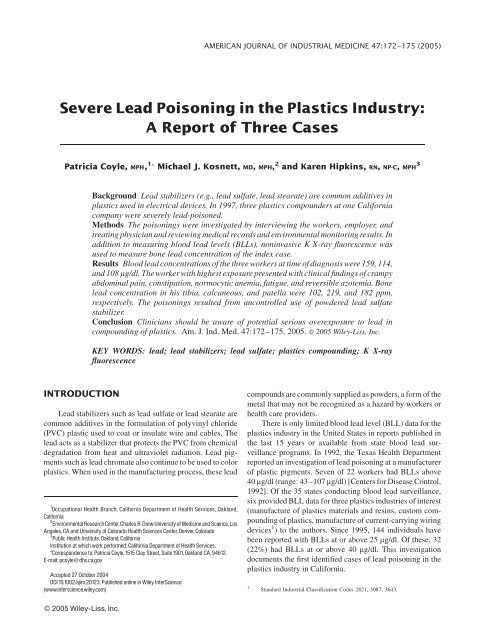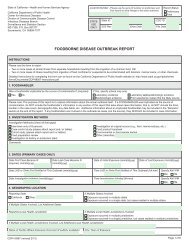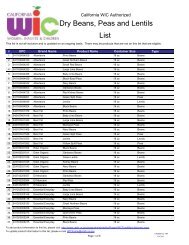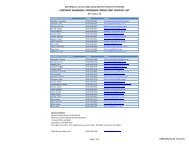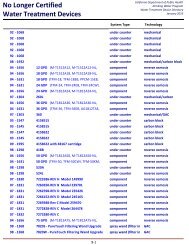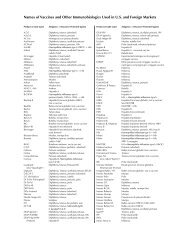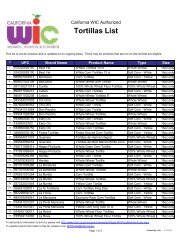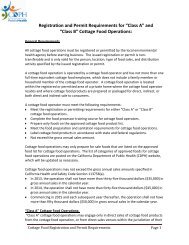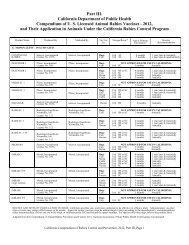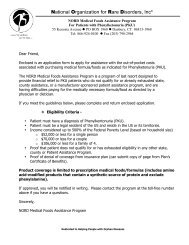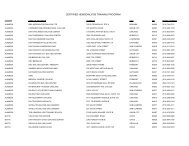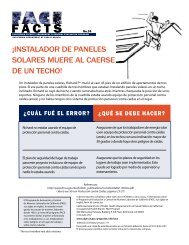Severe lead poisoning in the plastics industry - California ...
Severe lead poisoning in the plastics industry - California ...
Severe lead poisoning in the plastics industry - California ...
You also want an ePaper? Increase the reach of your titles
YUMPU automatically turns print PDFs into web optimized ePapers that Google loves.
AMERICAN JOURNAL OF INDUSTRIAL MEDICINE 47:172–175 (2005)<br />
<strong>Severe</strong> Lead Poison<strong>in</strong>g <strong>in</strong> <strong>the</strong> Plastics Industry:<br />
A Report of Three Cases<br />
Patricia Coyle, MPH, 1 Michael J. Kosnett, MD, MPH, 2 and Karen Hipk<strong>in</strong>s, RN, NP-C, MPH 3<br />
INTRODUCTION<br />
Background Lead stabilizers (e.g., <strong>lead</strong> sulfate, <strong>lead</strong> stearate) are common additives <strong>in</strong><br />
<strong>plastics</strong> used <strong>in</strong> electrical devices. In 1997, three <strong>plastics</strong> compounders at one <strong>California</strong><br />
company were severely <strong>lead</strong>-poisoned.<br />
Methods The <strong>poison<strong>in</strong>g</strong>s were <strong>in</strong>vestigated by <strong>in</strong>terview<strong>in</strong>g <strong>the</strong> workers, employer, and<br />
treat<strong>in</strong>g physician and review<strong>in</strong>g medical records and environmental monitor<strong>in</strong>g results. In<br />
addition to measur<strong>in</strong>g blood <strong>lead</strong> levels (BLLs), non<strong>in</strong>vasive K X-ray fluorescence was<br />
used to measure bone <strong>lead</strong> concentration of <strong>the</strong> <strong>in</strong>dex case.<br />
Results Blood <strong>lead</strong> concentrations of <strong>the</strong> three workers at time of diagnosis were 159, 114,<br />
and 108 mg/dl. The worker with highest exposure presented with cl<strong>in</strong>ical f<strong>in</strong>d<strong>in</strong>gs of crampy<br />
abdom<strong>in</strong>al pa<strong>in</strong>, constipation, normocytic anemia, fatigue, and reversible azotemia. Bone<br />
<strong>lead</strong> concentration <strong>in</strong> his tibia, calcaneous, and patella were 102, 219, and 182 ppm,<br />
respectively. The <strong>poison<strong>in</strong>g</strong>s resulted from uncontrolled use of powdered <strong>lead</strong> sulfate<br />
stabilizer.<br />
Conclusion Cl<strong>in</strong>icians should be aware of potential serious overexposure to <strong>lead</strong> <strong>in</strong><br />
compound<strong>in</strong>g of <strong>plastics</strong>. Am. J. Ind. Med. 47:172–175, 2005. ß 2005 Wiley-Liss, Inc.<br />
KEY WORDS: <strong>lead</strong>; <strong>lead</strong> stabilizers; <strong>lead</strong> sulfate; <strong>plastics</strong> compound<strong>in</strong>g; K X-ray<br />
fluorescence<br />
Lead stabilizers such as <strong>lead</strong> sulfate or <strong>lead</strong> stearate are<br />
common additives <strong>in</strong> <strong>the</strong> formulation of polyv<strong>in</strong>yl chloride<br />
(PVC) plastic used to coat or <strong>in</strong>sulate wire and cables. The<br />
<strong>lead</strong> acts as a stabilizer that protects <strong>the</strong> PVC from chemical<br />
degradation from heat and ultraviolet radiation. Lead pigments<br />
such as <strong>lead</strong> chromate also cont<strong>in</strong>ue to be used to color<br />
<strong>plastics</strong>. When used <strong>in</strong> <strong>the</strong> manufactur<strong>in</strong>g process, <strong>the</strong>se <strong>lead</strong><br />
1<br />
Occupational Health Branch, <strong>California</strong> Department of Health Services, Oakland,<br />
<strong>California</strong><br />
2<br />
Environmental Research Center,Charles R.Drew University of Medic<strong>in</strong>e and Science,Los<br />
Angeles, CA and University of Colorado Health Sciences Center, Denver, Colorado<br />
3<br />
Public Health Institute, Oakland, <strong>California</strong><br />
Institution at which work performed: <strong>California</strong> Department of Health Services.<br />
*Correspondence to: Patricia Coyle, 1515 Clay Street, Suite1901, Oakland CA, 94612.<br />
E-mail: pcoyle@dhs.ca.gov<br />
Accepted 27 October 2004<br />
DOI10.1002/ajim.20123. Published onl<strong>in</strong>e <strong>in</strong> Wiley InterScience<br />
(www.<strong>in</strong>terscience.wiley.com)<br />
ß2005Wiley-Liss,Inc.<br />
compounds are commonly supplied as powders, a form of <strong>the</strong><br />
metal that may not be recognized as a hazard by workers or<br />
health care providers.<br />
There is only limited blood <strong>lead</strong> level (BLL) data for <strong>the</strong><br />
<strong>plastics</strong> <strong>in</strong>dustry <strong>in</strong> <strong>the</strong> United States <strong>in</strong> reports published <strong>in</strong><br />
<strong>the</strong> last 15 years or available from state blood <strong>lead</strong> surveillance<br />
programs. In 1992, <strong>the</strong> Texas Health Department<br />
reported an <strong>in</strong>vestigation of <strong>lead</strong> <strong>poison<strong>in</strong>g</strong> at a manufacturer<br />
of plastic pigments. Seven of 22 workers had BLLs above<br />
40 mg/dl (range: 43–107 mg/dl) [Centers for Disease Control,<br />
1992]. Of <strong>the</strong> 35 states conduct<strong>in</strong>g blood <strong>lead</strong> surveillance,<br />
six provided BLL data for three <strong>plastics</strong> <strong>in</strong>dustries of <strong>in</strong>terest<br />
(manufacture of <strong>plastics</strong> materials and res<strong>in</strong>s, custom compound<strong>in</strong>g<br />
of <strong>plastics</strong>, manufacture of current-carry<strong>in</strong>g wir<strong>in</strong>g<br />
devices 1 ) to <strong>the</strong> authors. S<strong>in</strong>ce 1995, 144 <strong>in</strong>dividuals have<br />
been reported with BLLs at or above 25 mg/dl. Of <strong>the</strong>se, 32<br />
(22%) had BLLs at or above 40 mg/dl. This <strong>in</strong>vestigation<br />
documents <strong>the</strong> first identified cases of <strong>lead</strong> <strong>poison<strong>in</strong>g</strong> <strong>in</strong> <strong>the</strong><br />
<strong>plastics</strong> <strong>in</strong>dustry <strong>in</strong> <strong>California</strong>.<br />
1<br />
Standard Industrial Classification Codes 2821, 3087, 3643.
CASES<br />
In <strong>California</strong>, cl<strong>in</strong>ical laboratories are required to report<br />
all BLLs to <strong>the</strong> <strong>California</strong> Department of Health Services<br />
(CDHS). On November 12, 1997, <strong>the</strong> Occupational Lead<br />
Poison<strong>in</strong>g Prevention Program (OLPPP) <strong>in</strong> CDHS received<br />
two reports of an adult with a severely elevated BLL (159<br />
and 164 mg/dl 2 , performed 1 week apart). As part of its standard<br />
protocol to respond immediately to all BLLs 60 mg/dl,<br />
OLPPP <strong>in</strong>terviewed <strong>the</strong> affected <strong>in</strong>dividual (a compounder<br />
for a <strong>plastics</strong> manufacturer), his employer, and <strong>the</strong> treat<strong>in</strong>g<br />
physician with<strong>in</strong> a day of receipt of <strong>the</strong> BLL reports. The<br />
<strong>in</strong>itial <strong>in</strong>terviews revealed that <strong>the</strong> worker had symptomatic<br />
<strong>lead</strong> <strong>poison<strong>in</strong>g</strong> result<strong>in</strong>g from uncontrolled use of a powdered<br />
<strong>lead</strong> sulfate stabilizer <strong>in</strong> custom compound<strong>in</strong>g PVC plastic<br />
pellets <strong>in</strong>tended for use <strong>in</strong> electrical devices. Although <strong>the</strong><br />
<strong>in</strong>dex case had used this <strong>lead</strong> sulfate product at his current<br />
workplace for approximately 5 years, <strong>the</strong> employer had never<br />
provided any <strong>lead</strong>-related <strong>in</strong>dustrial hygiene monitor<strong>in</strong>g or<br />
BLL test<strong>in</strong>g.<br />
At OLPPP’s recommendation, <strong>the</strong> employer provided<br />
BLL test<strong>in</strong>g for <strong>the</strong> <strong>in</strong>dex case’s eight co-workers <strong>in</strong> <strong>the</strong><br />
company’s production department. The two o<strong>the</strong>r compounders<br />
had markedly elevated BLLs (114 and 108 mg/dl,<br />
respectively) and were symptomatic. All three <strong>lead</strong>-poisoned<br />
workers were removed immediately from <strong>lead</strong> exposure<br />
and chelated by a board-certified occupational medic<strong>in</strong>e<br />
physician. The six rema<strong>in</strong><strong>in</strong>g workers had BLLs rang<strong>in</strong>g<br />
from 4 to 48 mg/dl. For comparison, <strong>the</strong> geometric mean BLL<br />
for <strong>the</strong> United States general population and work<strong>in</strong>g aged<br />
adults is less than 2 mg/dl [Centers for Disease Control and<br />
Prevention, 2003]. Follow-up BLL test<strong>in</strong>g of workers’<br />
children also identified one child, a 3-month-old <strong>in</strong>fant, with<br />
an elevated BLL (10 mg/dl) [Centers for Disease Control,<br />
1991].<br />
The three poisoned workers were questioned about potential<br />
sources of <strong>lead</strong> exposure outside of <strong>the</strong>ir employment<br />
at <strong>the</strong> <strong>plastics</strong> company. None were engaged <strong>in</strong> o<strong>the</strong>r jobs or<br />
hobbies associated with <strong>lead</strong> exposure. The <strong>in</strong>dex case had<br />
been employed fulltime at <strong>the</strong> <strong>plastics</strong> compounder s<strong>in</strong>ce<br />
mid-1992. Between 1988 and 1991 he had performed <strong>plastics</strong><br />
compound<strong>in</strong>g for ano<strong>the</strong>r employer where powdered <strong>in</strong>gredients<br />
were rarely used and where he doubted that <strong>lead</strong><br />
additives had been encountered. Between 1985 and 1987 he<br />
had been employed do<strong>in</strong>g plastic extrusion mold<strong>in</strong>g but did<br />
not do compound<strong>in</strong>g. In <strong>the</strong> first part of 1992, <strong>the</strong> <strong>in</strong>dex case<br />
was employed as a compounder of rubber res<strong>in</strong>s.<br />
The review of <strong>the</strong> <strong>in</strong>dex case’s medical history <strong>in</strong>dicated<br />
that he reported chronic recurrent abdom<strong>in</strong>al pa<strong>in</strong> and muscle<br />
‘‘spasms’’ <strong>in</strong> his extremities to his personal physician<br />
2<br />
The Occupational Safety and Health Adm<strong>in</strong>istration requires medical removal<br />
of a worker with a blood <strong>lead</strong> level 60 mg/dl or an average BLL 50 mg /dl on<br />
<strong>the</strong> last three tests, or all tests over <strong>the</strong> previous 6 months.<br />
<strong>Severe</strong> Lead Poison<strong>in</strong>g <strong>in</strong> <strong>the</strong> Plastics Industry 173<br />
beg<strong>in</strong>n<strong>in</strong>g <strong>in</strong> approximately February 1996. Between January<br />
and November 1997, he suffered three severe bouts of<br />
abdom<strong>in</strong>al pa<strong>in</strong> accompanied by fatigue, decreased appetite,<br />
marked constipation, and <strong>the</strong> <strong>in</strong>ability to f<strong>in</strong>d a comfortable<br />
position while rest<strong>in</strong>g <strong>in</strong> bed at night. The first two episodes,<br />
which gradually <strong>in</strong>creased over a 3-day period and were<br />
exacerbated by movement, subsequently abated over <strong>the</strong><br />
course of 1 week. Medical consultation produced a presumptive<br />
diagnosis of gastritis or peptic ulcer, and H2 antagonists<br />
were prescribed; calcium supplementation was recommended<br />
for <strong>the</strong> muscle spasms. At <strong>the</strong> time of <strong>the</strong> third episode, <strong>in</strong><br />
November 1997, <strong>the</strong> worker requested a BLL because he had<br />
noticed that <strong>the</strong> bags of powder he worked with had ‘‘<strong>lead</strong>’’<br />
pr<strong>in</strong>ted on <strong>the</strong>m and were marked with a skull and crossbones.<br />
In addition to <strong>the</strong> BLL of 164 mg/dl, laboratory<br />
evaluation at that time revealed a serum creat<strong>in</strong><strong>in</strong>e of 2.9 mg/<br />
dl (normal range: 0.7–1.3), blood urea nitrogen 34 mg/dl (7–<br />
18), hemoglob<strong>in</strong> 11.0 g/dl (13.5–17.5), hematocrit 33.6%<br />
(40–54), and MCV 87 c/mcu (80–94).<br />
Follow<strong>in</strong>g <strong>the</strong> worker’s removal from <strong>the</strong> workplace and<br />
<strong>the</strong> first week of chelation with oral succimer, fur<strong>the</strong>r evaluation<br />
of his renal function revealed a creat<strong>in</strong><strong>in</strong>e clearance of<br />
49 ml/m<strong>in</strong> (normal range: 75–125); ur<strong>in</strong>alysis and abdom<strong>in</strong>al<br />
ultrasound were negative. Two weeks later, <strong>the</strong> serum<br />
creat<strong>in</strong><strong>in</strong>e had fallen to 1.4 mg/dl and rema<strong>in</strong>ed between 1.2<br />
and 1.4 mg/dl on multiple follow-up measurements over <strong>the</strong><br />
follow<strong>in</strong>g 8 months. BLL at <strong>the</strong> end of chelation reached a<br />
nadir of 19 mg/dl, but rebounded four weeks later to 54 mg/dl.<br />
Measurement of bone <strong>lead</strong> concentration by non<strong>in</strong>vasive, K<br />
X-ray fluorescence <strong>in</strong> October 1998 revealed a tibial (cortical<br />
bone) <strong>lead</strong> concentration of 102.1 3.0 ppm, calcaneous<br />
(trabecular bone) <strong>lead</strong> 219.1 7.1, and patellar (trabecular<br />
bone) <strong>lead</strong> 181.6 7.0 (all results approximately 10-fold<br />
greater than predicted for a male of his age). BLL at that time<br />
was 45.4 mg/dl.<br />
Investigation and Follow-Up<br />
This small employer custom compounds v<strong>in</strong>yl pellets<br />
from raw <strong>in</strong>gredients (powdered PVC res<strong>in</strong>, powdered stabilizer,<br />
and liquid lubricant). Lead sulfate was added as a<br />
stabilizer when formulat<strong>in</strong>g <strong>plastics</strong> for manufacturers of<br />
products such as <strong>in</strong>sulated electrical wir<strong>in</strong>g. Compounders<br />
frequently (often daily) mixed batches that used pure <strong>lead</strong><br />
sulfate as <strong>the</strong> stabilizer. Fifty-pound bags of <strong>lead</strong> sulfate were<br />
cut open and left unsealed <strong>in</strong> <strong>the</strong> production area; for each<br />
batch, a compounder hand-scooped six to eight pounds of<br />
pure <strong>lead</strong> sulfate powder and dumped it <strong>in</strong>to a large mix<strong>in</strong>g<br />
vat while wear<strong>in</strong>g a paper dust mask. Up to 34 batches were<br />
mixed per day. The <strong>in</strong>termediate product, a f<strong>in</strong>e compounded<br />
powder, came out a chute <strong>in</strong>to an open b<strong>in</strong> at <strong>the</strong> bottom of <strong>the</strong><br />
mixer. When <strong>the</strong> b<strong>in</strong> was full, it was moved by forklift to <strong>the</strong><br />
o<strong>the</strong>r side of <strong>the</strong> plant where it was dumped <strong>in</strong>to an extruder<br />
to form solid pieces of plastic that were <strong>the</strong>n fed <strong>in</strong>to a
174 Coyle et al.<br />
pellitizer to make <strong>the</strong> f<strong>in</strong>al product—pellets approximately<br />
1/2 00 long and 1/4 00 <strong>in</strong> diameter.<br />
There was no <strong>lead</strong> safety program at <strong>the</strong> company, and<br />
air monitor<strong>in</strong>g had never been performed. There was a local<br />
exhaust ventilation system at <strong>the</strong> mix<strong>in</strong>g station, but it was<br />
not evaluated regularly. Cleanup was done by dry sweep<strong>in</strong>g<br />
<strong>the</strong> shop floor. Workers ate and smoked <strong>in</strong> <strong>the</strong> production<br />
area, and some wore <strong>the</strong>ir work clo<strong>the</strong>s and shoes home. The<br />
<strong>in</strong>dex case reported us<strong>in</strong>g a compressed air hose to blow dust<br />
off his work clo<strong>the</strong>s prior to wear<strong>in</strong>g <strong>the</strong>m home. There were<br />
no showers at <strong>the</strong> worksite.<br />
The employer was unaware that <strong>lead</strong> sulfate posed a<br />
serious health hazard and of his responsibilities under <strong>the</strong><br />
OSHA General Industry Lead Standard (29 CFR 1910.1025).<br />
He had relied on <strong>the</strong> product Material Safety Data Sheet<br />
(MSDS) for <strong>in</strong>formation on health effects and guidance on<br />
protect<strong>in</strong>g his workers. 3 The MSDS for this product did not<br />
mention <strong>the</strong> effects of <strong>lead</strong> on <strong>the</strong> central nervous, bloodform<strong>in</strong>g,<br />
and reproductive systems, or its ability to cause<br />
kidney damage. The MSDS recommended that a ‘‘respirator<br />
for f<strong>in</strong>e dust’’ be used; <strong>the</strong> employer mistakenly thought this<br />
meant a dust mask, s<strong>in</strong>ce <strong>the</strong>re was no mention of HEPA (high<br />
efficiency particulate) filters, which he had seen specifically<br />
recommended on MSDSs for o<strong>the</strong>r products. Had <strong>the</strong><br />
MSDS recommended <strong>the</strong> appropriate respirator, a half-face<br />
respirator with HEPA filters, <strong>the</strong> employer stated that he<br />
would not have relied on dust masks to protect his employees.<br />
OLPPP made specific recommendations to correct<br />
problems identified dur<strong>in</strong>g employer and worker <strong>in</strong>terviews<br />
<strong>in</strong>clud<strong>in</strong>g significant changes <strong>in</strong> work practices, implementation<br />
of a respirator program, establish<strong>in</strong>g a medical surveillance<br />
program, conduct<strong>in</strong>g personal air monitor<strong>in</strong>g for <strong>lead</strong>,<br />
and tra<strong>in</strong><strong>in</strong>g workers.<br />
Air monitor<strong>in</strong>g, done several weeks after <strong>the</strong> <strong>in</strong>dex case<br />
was identified, showed personal air <strong>lead</strong> levels of 460–<br />
1,100 mg/m 3 (time-weighted average for sampl<strong>in</strong>g times of<br />
2.8 to 3.9 hr; <strong>the</strong> OSHA permissible exposure limit is 50 mg/<br />
m 3 , 8 hr time-weighted average). In <strong>the</strong> year after <strong>the</strong> <strong>in</strong>dex<br />
case was identified, <strong>the</strong> company switched to a pellet formulation<br />
of <strong>the</strong> stabilizer to reduce <strong>lead</strong> dust. Follow-up<br />
personal air monitor<strong>in</strong>g done <strong>in</strong> December 1998 cont<strong>in</strong>ued<br />
to show excessive air <strong>lead</strong> levels (20–400 mg/m 3 , 8 hr timeweighted<br />
average). In a fur<strong>the</strong>r effort to reduce exposure, <strong>the</strong><br />
company switched to a pre-packaged stabilizer <strong>in</strong> a dissolvable<br />
package that was added <strong>in</strong>tact to <strong>the</strong> mixer. Dur<strong>in</strong>g this<br />
time, compounders were required to wear half-face respirators<br />
with HEPA (P-100) filters. Air monitor<strong>in</strong>g conducted<br />
dur<strong>in</strong>g use of <strong>the</strong> pre-packaged stabilizer still showed<br />
excessive <strong>lead</strong> levels. Personal air <strong>lead</strong> levels ranged from<br />
3<br />
The MSDS lists <strong>the</strong> hazardous <strong>in</strong>gredients <strong>in</strong> a product, describes its health and<br />
safety hazards, and recommends appropriate measures for controll<strong>in</strong>g<br />
exposure. The manufacturer of a product conta<strong>in</strong><strong>in</strong>g hazardous substances is<br />
required by law to develop an MSDS. Employers are required by law to make<br />
this MSDS available to employees who use <strong>the</strong> product (29 CFR 1910.1200).<br />
3 to 210 mg/m 3 (8 hr time-weighted average). The source of<br />
<strong>the</strong> cont<strong>in</strong>ued high air <strong>lead</strong> levels was not clear. At <strong>the</strong> time of<br />
monitor<strong>in</strong>g, white powder was visible on <strong>the</strong> floor and<br />
surfaces throughout <strong>the</strong> shop and was likely kicked up <strong>in</strong>to<br />
<strong>the</strong> air by dry sweep<strong>in</strong>g, etc. The powder may have been <strong>lead</strong><br />
sulfate stabilizer left over from <strong>the</strong> time before <strong>the</strong> switch to<br />
<strong>the</strong> pre-packaged stabilizer, or may have been dust from <strong>the</strong><br />
<strong>in</strong>termediate product, a f<strong>in</strong>e compounded powder.<br />
Because of cont<strong>in</strong>u<strong>in</strong>g difficulty controll<strong>in</strong>g <strong>lead</strong> exposures,<br />
even with <strong>the</strong> use of a pre-packaged stabilizer, as well as a<br />
desire to go <strong>lead</strong>-free, <strong>the</strong> company began to research <strong>lead</strong>free<br />
substitutes. After a lengthy test<strong>in</strong>g process, <strong>the</strong> company<br />
found a <strong>lead</strong>-free plastic formulation that met Underwriters<br />
Laboratories, Inc. 14 performance requirements and was<br />
satisfactory to <strong>the</strong>ir customers. In November 2000 <strong>the</strong><br />
company switched to <strong>the</strong> <strong>lead</strong>-free stabilizer.<br />
In 1998, <strong>the</strong> Society of <strong>the</strong> Plastics Industry, at OLPPP’s<br />
request, alerted <strong>the</strong>ir membership to this potential problem<br />
via <strong>the</strong>ir newsletter and posted an alert on <strong>the</strong>ir website.<br />
OLPPP also sent a letter <strong>in</strong> February 1999 to <strong>the</strong> 392 <strong>California</strong><br />
employers that compound plastic res<strong>in</strong>s, or manufacture<br />
<strong>plastics</strong>, res<strong>in</strong>s, or current-carry<strong>in</strong>g wir<strong>in</strong>g devices.<br />
OLPPP notified Cal/OSHA of <strong>the</strong> deficient MSDS <strong>in</strong><br />
April 1998. OLPPP also notified federal OSHA <strong>in</strong> April 1999,<br />
and OSHA contacted <strong>the</strong> stabilizer importer <strong>in</strong> December<br />
1999 to correct <strong>the</strong> MSDS.<br />
DISCUSSION<br />
Index Case<br />
At <strong>the</strong> time of his <strong>in</strong>itial blood <strong>lead</strong> measurement of<br />
159 mg/dl, <strong>the</strong> <strong>in</strong>dex case had exhibited a constellation of<br />
signs and symptoms characteristic of overt chronic <strong>lead</strong><br />
<strong>poison<strong>in</strong>g</strong>, <strong>in</strong>clud<strong>in</strong>g episodic bouts of crampy abdom<strong>in</strong>al<br />
pa<strong>in</strong>, constipation, fatigue, and normocytic anemia [Lilis<br />
et al., 1968; Hamilton and Hardy, 1974; Pagliuca et al., 1990;<br />
Kosnett, 2005]. The reversible renal <strong>in</strong>sufficiency exhibited<br />
by <strong>the</strong> patient is a less common feature of severe <strong>lead</strong><br />
<strong>poison<strong>in</strong>g</strong>. At <strong>the</strong> time of his presentation <strong>in</strong> November 1997,<br />
<strong>the</strong> patient had a serum creat<strong>in</strong><strong>in</strong>e that peaked at 2.9 mg/dl,<br />
and a creat<strong>in</strong><strong>in</strong>e clearance of 49 ml/m<strong>in</strong> (normal: 75–125).<br />
The patient’s serum creat<strong>in</strong><strong>in</strong>e decl<strong>in</strong>ed dur<strong>in</strong>g <strong>lead</strong> chelation<br />
with succimer, and by <strong>the</strong> spr<strong>in</strong>g of 1998 had appeared to<br />
stabilize <strong>in</strong> <strong>the</strong> range of 1.2–1.4 mg/dl. The reversibility of<br />
renal <strong>in</strong>sufficiency occurr<strong>in</strong>g as a result of massive acute <strong>lead</strong><br />
exposure (or acute on chronic exposure), has been described<br />
<strong>in</strong> <strong>the</strong> medical literature [Radosevic et al., 1961; Lilis et al.,<br />
1968]. Ra<strong>the</strong>r than reflect<strong>in</strong>g tubular <strong>in</strong>terstitial scarr<strong>in</strong>g, a<br />
sequelae of chronic <strong>lead</strong> exposure that is irreversible, <strong>the</strong><br />
4<br />
Underwriters Laboratories, Inc. 1 is an <strong>in</strong>dependent, not-for-profit product<br />
safety test<strong>in</strong>g and certification organization.
eversible component may be due to a vasoconstrictive effect<br />
of high <strong>lead</strong> levels on renovascular smooth muscle [Lilis<br />
et al., 1968; Chai and Webb, 1988], possibly ak<strong>in</strong> to <strong>the</strong><br />
reversible <strong>in</strong>creases <strong>in</strong> <strong>in</strong>test<strong>in</strong>al smooth muscle tone<br />
associated with <strong>lead</strong> colic [Jan<strong>in</strong> et al., 1985]. Improvement<br />
<strong>in</strong> <strong>lead</strong>-<strong>in</strong>duced renal <strong>in</strong>sufficiency follow<strong>in</strong>g succimer<br />
chelation has been described <strong>in</strong> an animal model [Khalil-<br />
Manesh et al., 1992]. Although <strong>the</strong> patient’s serum creat<strong>in</strong><strong>in</strong>e<br />
decl<strong>in</strong>ed from <strong>the</strong> peak value of 2.9, it rema<strong>in</strong>ed significantly<br />
higher than his value of 1.0 measured <strong>in</strong> May 1996. Thus, a<br />
component of subcl<strong>in</strong>ical chronic <strong>lead</strong> nephropathy may also<br />
be present.<br />
Because greater than 90% of <strong>the</strong> body <strong>lead</strong> burden<br />
resides <strong>in</strong> bone, where it persists with a half-life of years to<br />
decades, non-<strong>in</strong>vasive measurement of <strong>lead</strong> <strong>in</strong> bone by K Xray<br />
fluorescence has found cl<strong>in</strong>ical utility as a biomarker of<br />
long-term, cumulative <strong>lead</strong> exposure. In several workplace<br />
studies, a s<strong>in</strong>gle measurement of <strong>lead</strong> <strong>in</strong> bone has correlated<br />
strongly with time-<strong>in</strong>tegrated blood <strong>lead</strong> measurements<br />
accumulated from years of past biological monitor<strong>in</strong>g [Roels<br />
et al., 1995]. Although no prior BLLs were available for <strong>the</strong><br />
<strong>in</strong>dex case, his markedly elevated bone <strong>lead</strong> concentrations,<br />
at <strong>the</strong> upper range of bone <strong>lead</strong> values found <strong>in</strong> long-term <strong>lead</strong><br />
smelter workers [Gerhardsson et al., 1993; Flem<strong>in</strong>g et al.,<br />
1998], are consistent with his hav<strong>in</strong>g susta<strong>in</strong>ed years of high<br />
dose <strong>lead</strong> exposure as a <strong>plastics</strong> compounder and rubber<br />
maker.<br />
Prevention Strategies/<br />
Recommendations<br />
Employers commonly rely on MSDSs for determ<strong>in</strong><strong>in</strong>g<br />
hazards and appropriate worker protections s<strong>in</strong>ce manufacturers<br />
must by law supply <strong>the</strong>m and <strong>the</strong>y are <strong>the</strong>refore readily<br />
available. However, <strong>the</strong> quality of MSDSs varies greatly and<br />
can be grossly <strong>in</strong>adequate. Nei<strong>the</strong>r federal OSHA nor Cal/<br />
OSHA rout<strong>in</strong>ely reviews MSDSs for accuracy and completeness.<br />
This <strong>in</strong>cident po<strong>in</strong>ts out <strong>the</strong> danger of rely<strong>in</strong>g solely on<br />
MSDSs for accurate health effects and worker protection<br />
<strong>in</strong>formation. Employers should always be encouraged to<br />
seek additional health and safety <strong>in</strong>formation on <strong>the</strong> hazardous<br />
materials <strong>in</strong> <strong>the</strong> products <strong>the</strong>y use from OSHA consultation<br />
programs, state health department occupational health<br />
programs, workers’ compensation carriers, or private occupational<br />
health and <strong>in</strong>dustrial hygiene consultants. Trade<br />
associations can also assist <strong>the</strong> hazard communication process<br />
by <strong>in</strong>form<strong>in</strong>g member companies of potential hazards<br />
associated with materials or products commonly used <strong>in</strong><br />
relevant <strong>in</strong>dustrial processes.<br />
This example demonstrates that even eng<strong>in</strong>eer<strong>in</strong>g controls,<br />
such as switch<strong>in</strong>g to a pre-packaged stabilizer, may not<br />
be sufficient to control <strong>lead</strong> exposures. In this <strong>in</strong>stance air<br />
<strong>Severe</strong> Lead Poison<strong>in</strong>g <strong>in</strong> <strong>the</strong> Plastics Industry 175<br />
<strong>lead</strong> levels cont<strong>in</strong>ued to be excessive even with <strong>the</strong> use of <strong>the</strong><br />
pre-packaged product. Substitution of <strong>lead</strong>-conta<strong>in</strong><strong>in</strong>g stabilizers<br />
with a less hazardous <strong>lead</strong>-free stabilizer is <strong>the</strong> surest<br />
way to protect workers.<br />
The employer <strong>in</strong> this case was a small bus<strong>in</strong>ess manufactur<strong>in</strong>g<br />
a specialty product. There are likely o<strong>the</strong>r companies<br />
who perform similar work. Occupational medic<strong>in</strong>e<br />
providers, <strong>in</strong>dustrial hygienists, and OSHA <strong>in</strong>spectors should<br />
be aware of <strong>the</strong> possibility of significant <strong>lead</strong> exposure <strong>in</strong> <strong>the</strong><br />
<strong>plastics</strong> <strong>in</strong>dustries.<br />
REFERENCES<br />
Centers for Disease Control. 1991. Prevent<strong>in</strong>g <strong>lead</strong> <strong>poison<strong>in</strong>g</strong> <strong>in</strong> young<br />
children: A statement by <strong>the</strong> Centers for Disease Control. Atlanta, GA:<br />
US Department of Health and Human Services, Public Health Service.<br />
Centers for Disease Control. 1992. Lead chromate exposures and<br />
elevated blood <strong>lead</strong> levels <strong>in</strong> workers <strong>in</strong> <strong>the</strong> <strong>plastics</strong> pigment<strong>in</strong>g<br />
<strong>in</strong>dustry—Texas, 1990. MMWR 41:304–306.<br />
Centers for Disease Control and Prevention. 2003. Second national<br />
report on human exposure to environmental chemicals. NCEH Pub. No.<br />
030022. Atlanta, GA: US Department of Health and Human Services,<br />
Public Health Service. p 9–12.<br />
Chai S, Webb RC. 1988. Effects of <strong>lead</strong> on vascular reactivity. Environ<br />
Health Perspect 78:85–89.<br />
Flem<strong>in</strong>g DEB, Chettle DR, Wetmur JG, Desnick RJ, Rob<strong>in</strong> JP, Boulay<br />
D, Richard NS, Gordon CL, Webber CE. 1998. Effect of <strong>the</strong>am<strong>in</strong>olevul<strong>in</strong>ate<br />
dehydratase polymorphism on <strong>the</strong> accumulation of<br />
<strong>lead</strong> <strong>in</strong> bone and blood <strong>in</strong> smelter workers. Environ Res (Section A)<br />
77:49–61.<br />
Gerhardsson L, Attewell R, Chettle DR, Englyst V, Lundstrom NG,<br />
Nordberg GF, Nyhl<strong>in</strong> H, Scott MC, Todd AC. 1993. In vivo<br />
measurement of <strong>lead</strong> <strong>in</strong> bone <strong>in</strong> long-term exposed <strong>lead</strong> smelter<br />
workers. Arch Environ Health 48:147–156.<br />
Hamilton A, Hardy HL. 1974. Lead. In: Industrial Toxicology, 3rd<br />
Edition. Acton, MA: Publish<strong>in</strong>g Sciences. p 85-2.<br />
Jan<strong>in</strong> Y, Cou<strong>in</strong>uad C, Stone A, Wise L. 1985. The ‘‘<strong>lead</strong>-<strong>in</strong>duced colic’’<br />
syndrome <strong>in</strong> <strong>lead</strong> <strong>in</strong>toxication. Surg Annu 17:287–307.<br />
Khalil-Manesh F, Gonick HC, Cohen A, Bergamaschi E, Mutti A. 1992.<br />
Experimental model of <strong>lead</strong> nephropathy. II. Effect of removal from <strong>lead</strong><br />
exposure and chelation treatment with dimercaptosucc<strong>in</strong>ic acid<br />
(DMSA). Environ Res 58:35–54.<br />
Kosnett MJ. 2005. Lead. In: Brent J, Wallace K, Burkhart KB, editors.<br />
Critical care toxicology: The diagnosis and management of <strong>the</strong> acutely<br />
poisoned patient. PA: Elsevier, p 821–836.<br />
Lilis R, Gavnlescu B, Nestorescu B, Dumitriu C, Roventa A. 1968.<br />
Nephropathy <strong>in</strong> chronic <strong>lead</strong> <strong>poison<strong>in</strong>g</strong>. Br J Ind Med 25:196–202.<br />
Pagliuca A, Mufti GJ, Baldw<strong>in</strong> D, Lestas AN, Wallis RM, Bell<strong>in</strong>gham<br />
AJ. 1990. Lead <strong>poison<strong>in</strong>g</strong>: Cl<strong>in</strong>ical, biochemical, and haematological<br />
aspects of a recent outbreak. J Cl<strong>in</strong> Pathol 43:277–281.<br />
Radosevic Z, Saric M, Beritic T, Knezevic J. 1961. The kidney <strong>in</strong> <strong>lead</strong><br />
<strong>poison<strong>in</strong>g</strong>. Brit J Ind Med 18:220–230.<br />
Roels H, Kon<strong>in</strong>gs J, Green S, Bradley D, Chettle D, Lauwerys R. 1995.<br />
Time-<strong>in</strong>tegrated blood <strong>lead</strong> concentration is a valid surrogate for<br />
estimat<strong>in</strong>g <strong>the</strong> cumulative <strong>lead</strong> dose assessed by tibial <strong>lead</strong> measurement.<br />
Env Res 69:74–82.


